Artists
In Her Fiery, Angelic Scenes, Naudline Pierre Is Painting New Mythologies
The Brooklyn-based artist charts new compositional territory in "The Mythic Age" now on view at James Cohan Gallery.
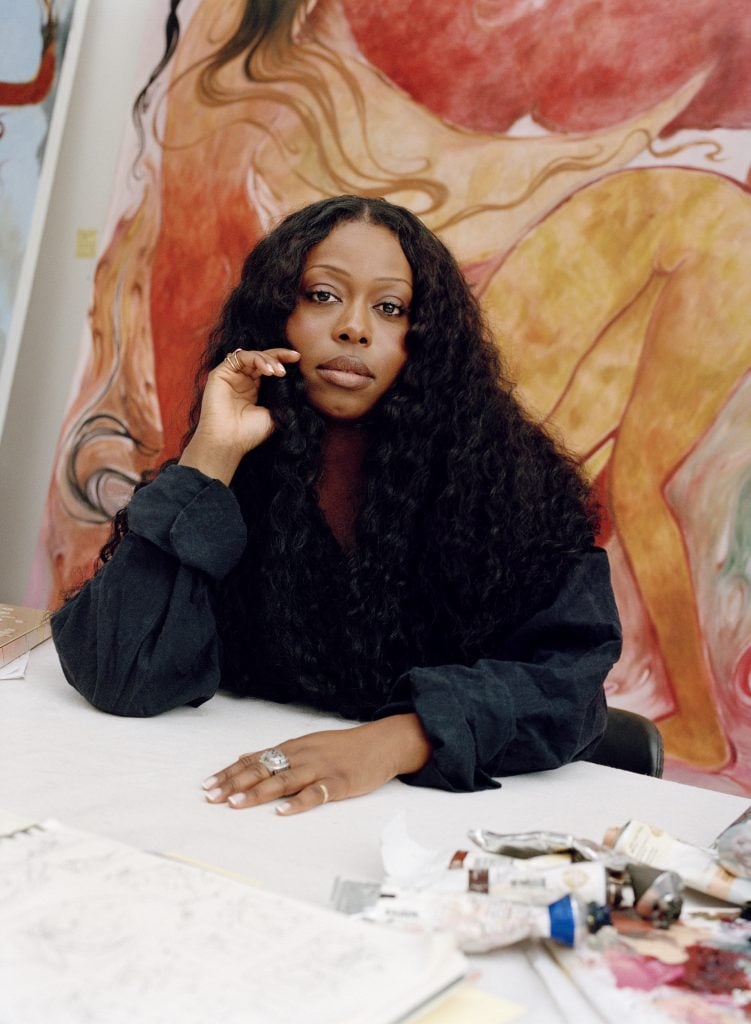
“Everything is alive and breathing,” said artist Naudline Pierre at her Greenpoint, Brooklyn, studio, one morning this past August. She was referring to her most recent paintings, towering canvases, filled with sensuous mythical beings for which Pierre has become well-known. That morning, Pierre was putting the final touches on the paintings before having them shipped over the bridge to Manhattan for her solo exhibition, “The Mythic Age” which opened at James Cohan Gallery last week.
Looking closely at the works, I saw Pierre was right. Unexpected details of the works were animate: the faces of plump cherubs appeared in rose-colored clouds, flickering flames wore electrifying grins, and the long hair of her mythical figures unfurled like serpents. Energy coursed from top to bottom and in diagonals across the canvases. “With these works, I’m painting purely from the joy of painting,” she added, with a soft smile.
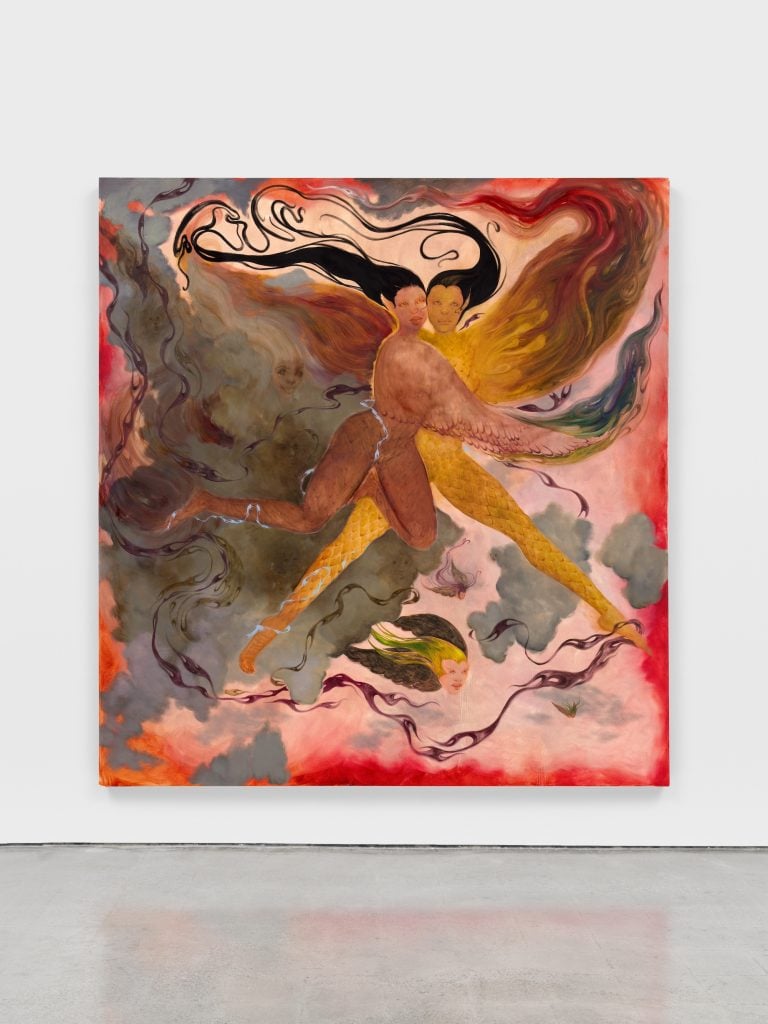
Naudline Pierre, A Remembering (2024). Courtesy of the artist and James Cohan Gallery.
Pierre has been a rising presence in the art world for the past five years, earning attention with her rapturous, fiery jewel-toned scenes of an unearthly realm filled with winged beings and cherubs. Soon after earning her MFA in painting from the New York Academy of Art in 2017, Pierre burst on the gallery scene with her debut solo show “Visitors” at Thierry Goldberg in New York that same year. Her West Coast solo debut came in 2019 at Shulamit Nazarian in Los Angeles. Pierre was then awarded an esteemed Studio Museum artist residency for 2019–2020 which concluded with a three-artist exhibition at MoMA PS1. Pierre has continued her ascent in the museum world since, with her debut solo exhibition “What Could Be Has Not Yet Appeared” at the Dallas Museum of Art (2021) followed by “This Is Not All There Is” a solo exhibition of works on paper at the Drawing Center in New York in 2023.
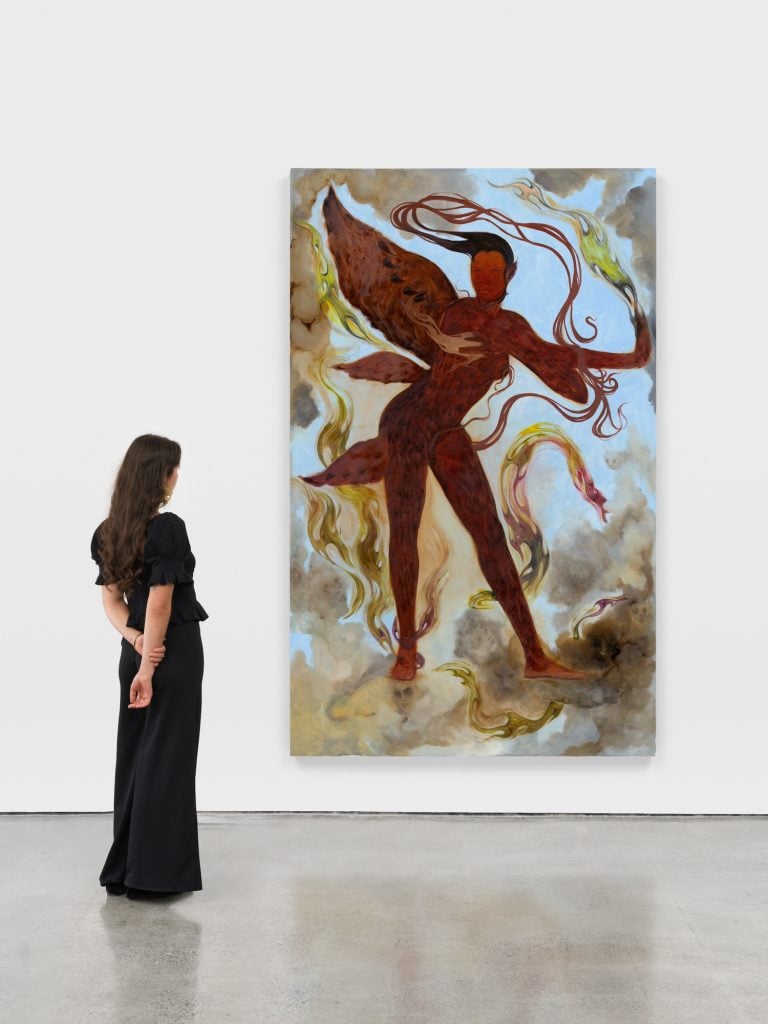
Naudline Pierre, The Fullness Of (2024). Courtesy of the artist and James Cohan Gallery.
Now represented by James Cohan Gallery, “The Mythic Age” follows Pierre’s 2022 solo exhibition “Enter the Realm” with the gallery and charts luminous new territory for the artist. What was most conspicuous to me is that the decadent jewel tones of purples, amethysts, and emerald greens that defined earlier works have given way to pastels of blues and pinks. An ethereality, a lyrical sense of dance, has sprung up in its place. Those familiar with Pierre’s works will notice another change too. For the better part of a decade, a central character, a woman, acted as the main protagonist in Pierre’s work. Often described as an “avatar” and an “alter ego” the figure appeared, in moments of joy, tenderness, rage, and despair, amid an array of winged seraphim who seemed intent on guiding and protecting her. In these new works, the central character is gone and Pierre has shifted our gaze fully to these mythical beings, offering them her complete attention. “I wanted to give all of the supporting characters a chance to be on the center stage—the flames, clouds, locks of hair, it’s all playing a role,” she explained.
Pierre often describes her characters as “appearing” to her. These new paintings don’t form a narrative but offer snapshots of the mythical figures existing out of time. “They understand that they’re being watched, but they don’t care. There is a powerful, feminine, transformative element about this work,” she said. While her figures appear as women, Pierre emphasizes that these beings exist outside of terrestrial limitations. “They come across as women, but I’ve always thought they go beyond gender. They appear to me in a way that I can understand and relate to,” she said, “These beings are sustaining me, literally, financially and emotionally, and doing me a favor as appearing to me as these figures. But they are much more dynamic and powerful than anything I could even conceptualize.”
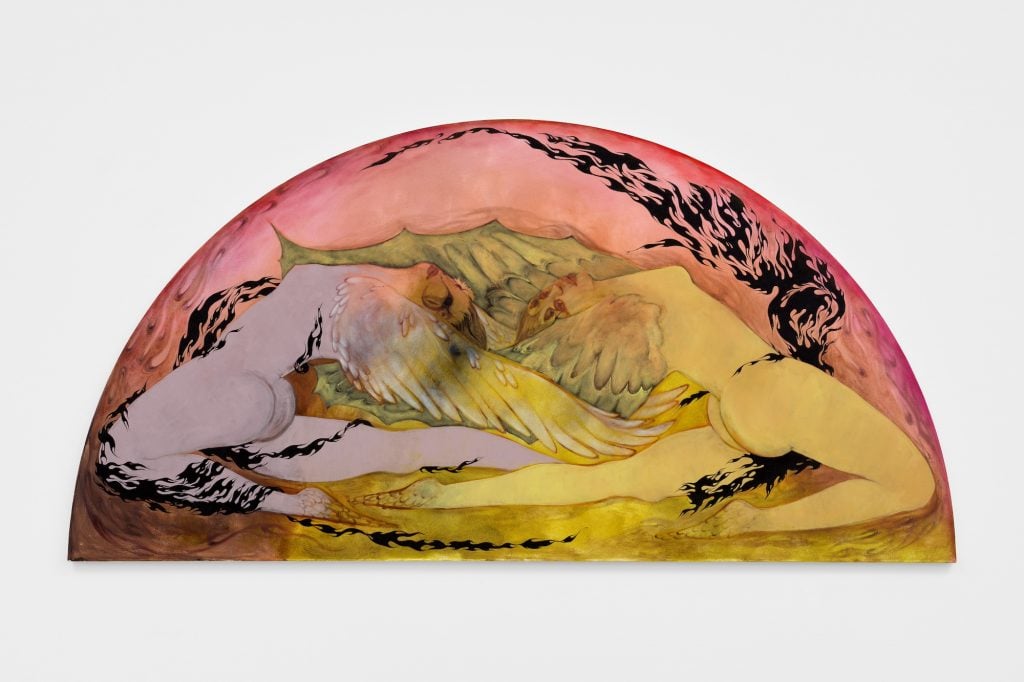
Naudline Pierre, The End is the Beginning (2024). Courtesy of the artist and James Cohan Gallery.
Now Pierres’s seraphim alight, in moments, in pale blue skies or amid fluffy clouds, offering for the first time hints of orientation to the celestial world they inhabit (by contrast in a 2021 profile, Steph Eckardt wrote “These seraphic beings float and swoop about in a sort of celestial vacuum; there are no landmarks or horizons in sight”). These shifts were inspired by a trip to Paris last year and a visit to the exhibition “Naples in Paris” at the Louvre, which chronicled paintings in Italy across the centuries.
“Many of the themes in the show were mythical and right up my alley. After seeing those paintings, I wanted to see how I could translate a shift in my color palette,” she explained. “There are a lot of pastel undertones and I’ve never really done a body of work that was exclusively like in the sky and dealing with clouds.” The painting The Fullness Of is particularly revealing, with a russet-colored angel posed in a pale blue sky, an image reminiscent of depictions of the Archangel Michael brandishing his sword in the heavens, and hinting at the Baroque and French academic painting of the 1800s. “I was thinking of Fragonard’s blue making this painting for sure,” she added.
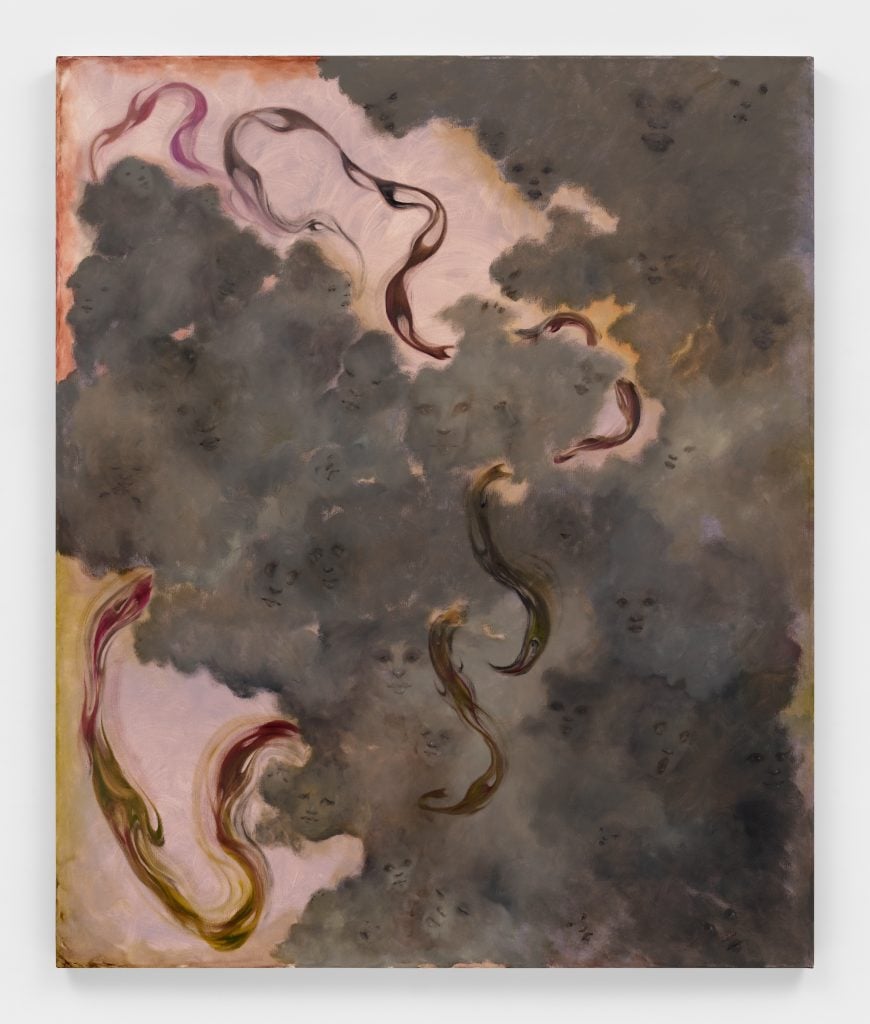
Naudline Pierre, A Hopeful Many (2024). Courtesy of the artist and James Cohan Gallery.
Pierre’s works have long been in conversation with masters of Western art history, with the artist adopting tropes, symbols, and styles from different eras, and metabolizing them into her own vision of a celestial realm, one she has filled with Black figures, from her central character to her angels. Religious art, in particular, has resonated with the artist. Born in Massachusetts, the daughter of Haitian immigrants, Pierre had a deeply religious upbringing. Her father was a pastor, who espoused a vision of Christianity in which the rapture and the hereafter exist as imminent realities, rather than far-off ideas. The flames of death and rebirth, agonies, and ecstasies of Pierre’s works all draw from the iconography of Christian religious art, but their intent is different. “I used to resent all the imagery of fear, but I’ve found a way to use it to express myself,” she said, “There are beautiful artworks I wanted to see myself in, and I’ve done that.”
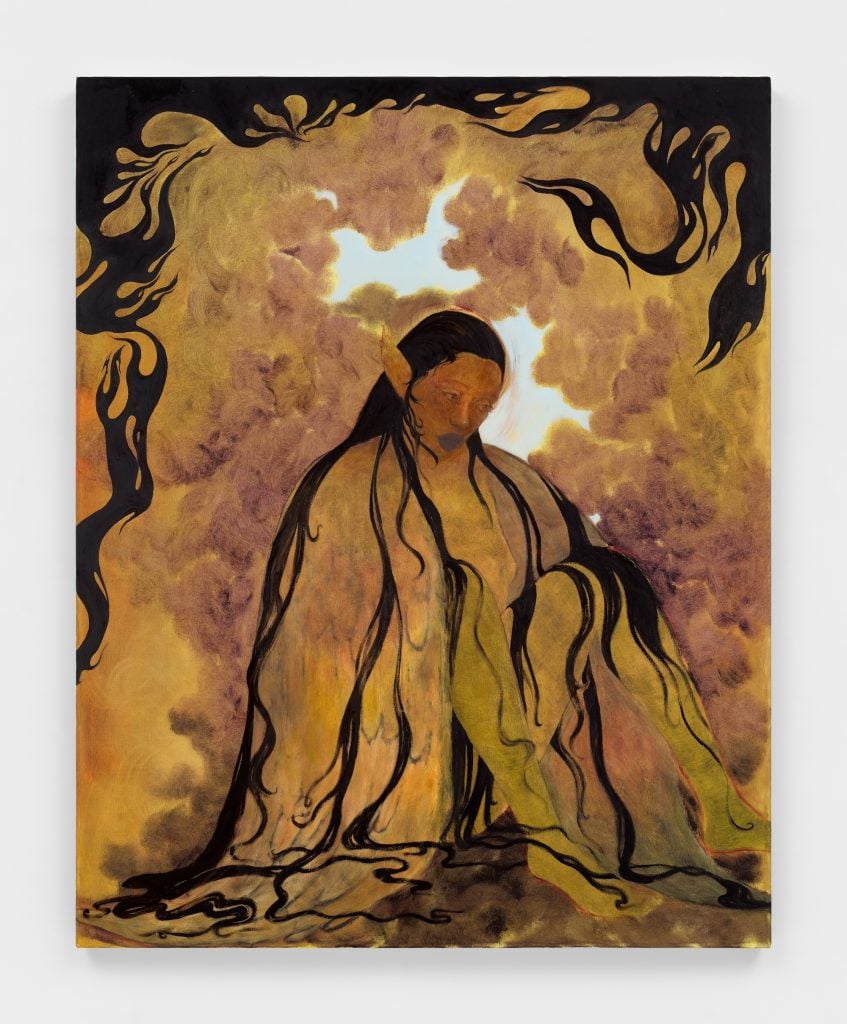
Naudline Pierre, It Appears in Solitude (2024). Courtesy of the artist and James Cohan Gallery.
For Pierre, these signs and symbols are her most honest language for translating universal moments of emotional transformation. “The flames signify change and transformation. Flames, to me, are beautiful, but fire can be painful too, and I think that the flames in these works are about the pains of change and growth,” she explained. In that sense, she finds parallels with El Greco, the Greek artist of the Spanish Renaissance whose dramatic, attenuated, and expressive style captured the ravishments of religious devotion. “I just think about the way El Greco painted, which was this punk sci-fi weirdness. He painted this dry brushy, chunky painting, but then strangely, his figures felt Mannerist—though Mannerism hadn’t happened yet,” she said, “That mixing of the familiar with uncanny is something I relate to with El Greco. The way he painted the Ascension or other biblical scenes, clouds were animated in their own right. There’s so much more in there than just an Ascension happening in his work.”
William Blake, too, offers a point of conversation, she added (I’d noticed a mammoth catalogue of Blake’s work, resting center on her studio table). “Blake is a huge part of my growing into painting as a form of healing and expansion,” she said “But I’m not sure I’m interested in him as a person and what he stood for, but his connection to material. Sometimes I’m like a pirate going through art history. I take what I want and leave the rest. That’s not my responsibility.”
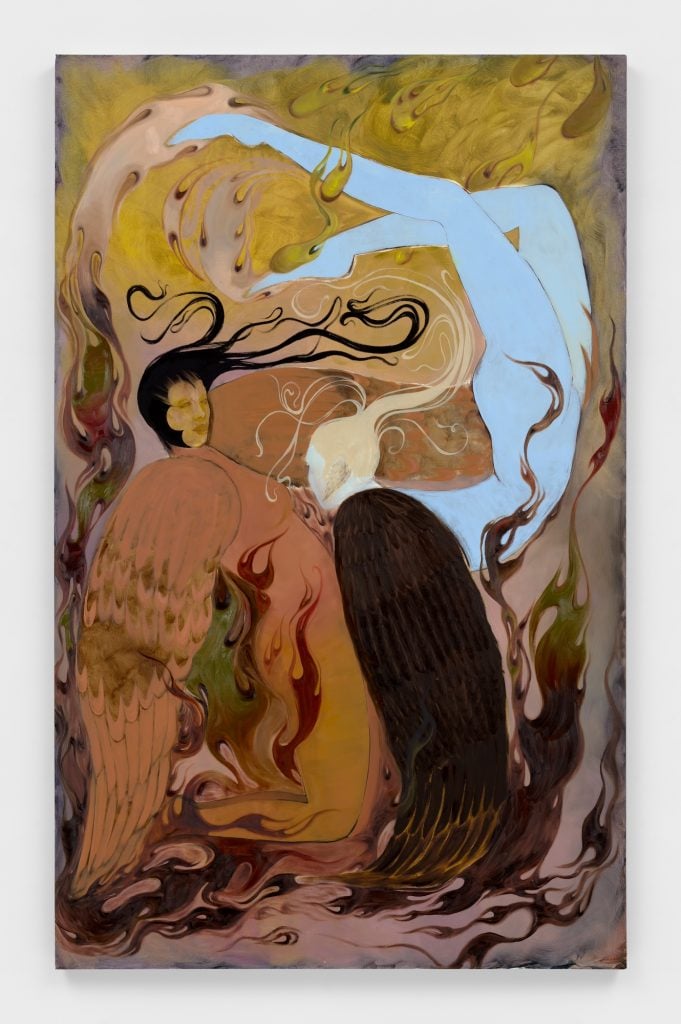
Naudline Pierre, Suspended in Tempo (2024). Courtesy of the artist and James Cohan Gallery.
Looking at these works, I had the sense that her most recent paintings are more rooted in mythology than religion. Her figures appear in cascading motion, in poses reminiscent of dance. Their sinuous hair unfurls in tendrils, almost Medusa-like in its power. I was reminded of her inspirational trip to Paris—a place she says “always fills me with beauty”—and thought of Art Nouveau artists with their embrace of vegetal loopings and lyricism. “I always think of my works as my own mythology, mixing together all the things that make me, me… everything that I’ve absorbed throughout my life and still am absorbing,” she added.
Pierre has dreams of expanding her mythical world in new ways, too. The artist has been experimenting with sculptural works recently and she has dreams of bringing her mythical figures into film. But for now, she’s taking a moment to rest.
“There’s a certain trust and communication with these characters where I’m asking ‘What do you want from me? What am I supposed to do next?'” she said. “The answer isn’t always here in the studio. Sometimes the answer is living my life, experiencing life, or taking a long nap. I try to remind myself that this is more than just a physical process. It’s an emotional process and it’s also a spiritual one.”





